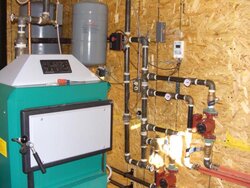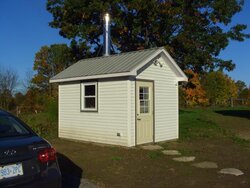Success at Last! Attempted my third burn last night after two other attempts that failed to provide much heat or gasification.
The first attempt I ensured the primary/secondary/fan settings were as suggested in the new EKO manual (primary = 10mm, Secondary =3.5 turns, and fan = 10% open wood = 12 - 16% mcg operated 4-way mixing valve manually ). Result was poor heat output and plenty of smoke. Tried adjusting secondary between 3 -6 turns and increased fan opening to about 20%.
The second attempt obtained similar results as above. The only difference was that I got the 4-way mixing valve operating with the Tekmar controller and this kept the main pump running but still low temp (60-65 C) and unable to maintain O/P under load.
Third attempt I placed my wifes digital meat thermometer in stove pipe with all settings as per the manual. The maximum stack temperature I could achieve was 155F. I opened the Fan a bit more and the stack temperature began to increase. I kept opening the fan a little bit at a time and the stack temperature kept on increasing. When I got to about 50% open I obtained very good gasification and no smoke from the chimney. I put in some more wood and It worked great over night going into idle from time to time, but re-entering good gasification when out of idle.
My question is since I needed to open the fan up so much (50%) to obtain gasification do you think that this indicates the I should try to open the primary setting some more to see if I can reduce the fan opening? Why do you think I needed to open the fan up so much? Note: My chimney is 8" insulated and the top is 16' tall measured from the floor of the outdoor shed. Draft issue?
Don
The first attempt I ensured the primary/secondary/fan settings were as suggested in the new EKO manual (primary = 10mm, Secondary =3.5 turns, and fan = 10% open wood = 12 - 16% mcg operated 4-way mixing valve manually ). Result was poor heat output and plenty of smoke. Tried adjusting secondary between 3 -6 turns and increased fan opening to about 20%.
The second attempt obtained similar results as above. The only difference was that I got the 4-way mixing valve operating with the Tekmar controller and this kept the main pump running but still low temp (60-65 C) and unable to maintain O/P under load.
Third attempt I placed my wifes digital meat thermometer in stove pipe with all settings as per the manual. The maximum stack temperature I could achieve was 155F. I opened the Fan a bit more and the stack temperature began to increase. I kept opening the fan a little bit at a time and the stack temperature kept on increasing. When I got to about 50% open I obtained very good gasification and no smoke from the chimney. I put in some more wood and It worked great over night going into idle from time to time, but re-entering good gasification when out of idle.
My question is since I needed to open the fan up so much (50%) to obtain gasification do you think that this indicates the I should try to open the primary setting some more to see if I can reduce the fan opening? Why do you think I needed to open the fan up so much? Note: My chimney is 8" insulated and the top is 16' tall measured from the floor of the outdoor shed. Draft issue?
Don



